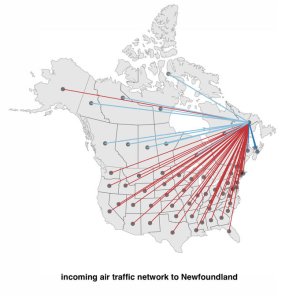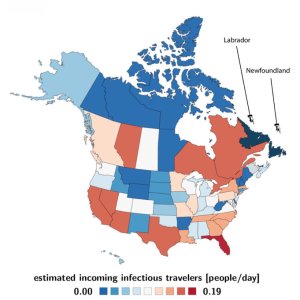When Oxford Mathematician Alain Goriely was approached by his collaborator Ellen Kuhl from Stanford University to work on a travel restriction issue in Newfoundland he started a Coronavirus journey that ended up in the Canadian Supreme Court.
"The island of Newfoundland is part of the Canadian province of Newfoundland and Labrador. Following a travel ban on May 5, 2020, this Atlantic province enjoyed the rather exceptional and enviable position of having the Coronavirus pandemic under control. By July 3, 2020, it had a cumulative number of 261 cases, with 258 recovered, 3 deaths, and no new cases for 36 days. The same day, the Atlantic Bubble opened to allow air travel between the four Atlantic Provinces - Newfoundland and Labrador, Nova Scotia, New Brunswick, and Prince Edward Island - with no quarantine requirements for travellers. With respect to COVID, the inhabitants of the province are in a dangerous position as they have the highest rates of obesity, metabolic disease, and cancer nationally, and an unhealthy lifestyle with the highest rate of cigarette smoking among all provinces. Despite its success in eliminating the virus, the government found itself in a precarious position. Its travel ban, Bill 38, was being challenged by a Halifax resident who was denied entry for her mother’s funeral in the Spring and the lawsuit was further supported by the Canadian Civil Liberties Association. They were seeking a declaration from the provincial Supreme Court in St John’s that the travel ban was unconstitutional, a decision that could apply to the entire country. Determined to keep control of its borders, the Office of the Attorney-General reached out to Ellen. Would her models be applicable to this situation? What would happen during gradual or full reopening under perfect or imperfect quarantine conditions?
Ellen and I had been talking about a hypothetical problem like this one. If the virus is eliminated from a region, can it come back, like a boomerang, when restrictions are eased? Newfoundland seemed to be the perfect case study for us, and with the help of her outstanding Postdoc, Kevin Linka and Dr Proton Rahman, a clinical epidemiologist and Professor of Medicine at Memorial University of Newfoundland, we jumped at the opportunity to test some of our ideas. Soon, we converged on a network model where each node represents a US state or a Canadian province. On each node, we ran a local Suscetible-Exposed-Infected-Recovered epidemiological model and modelled air traffic by a graph Laplacian-type transport process as commonly done for network transport. Parameters were estimated by Bayesian inference with Markov-chain Monte Carlo sampling using a Student’s t-distribution for the likelihood between the reported cumulative case numbers and the simulated cumulative case numbers.
Conceptually, the model is quite simple. I have a natural preference for parsimony when it comes to modelling complex phenomena as the assumptions are completely known and in full display. This is a personal choice and the outcomes of such models should be seen as estimates rather than a hardcore forecast. What we found is quite interesting. Using air traffic information from the previous 15 months, we showed that opening Newfoundland to the Atlantic provinces or the rest of Canada would have negligible effects on the evolution of the disease as prevalence dropped considerably in Canada. Yet, opening the airports to the USA would lead to 2-5 infected passengers entering the island a week, with as many as 1-2 asymptomatic travellers. Without an air-tight quarantine system, the disease would reach 0.1% of the Newfoundland population within 1 to 2 months.
In the first week of August, evidence were presented to the court. The Chief Medical Officer of Health Dr. Janice Fitzgerald opened with the following quote: “In 1775 the American revolutionary Patrick Henry declared, ’Give me liberty or give me death.’ In this case, if the applicants’ remedy is granted, it will result in both.” The same week Proton testified in court about our model, its assumptions, and our findings. To my surprise, the scientists were heard and on 17 September, the judge rendered his verdict. In his ruling, Justice Burrage declared that ‘‘The upshot of the modelling ... is that the travel restriction is an effective measure at reducing the spread of COVID19 in Newfoundland and Labrador.” He concluded that yes, the ban was legal and justified. Having an impact on the lives of Newfoundlanders, however small, is a strange but rather pleasant feeling."
Read more about the case here.
Figures above:
1. Mobility modelling. Discrete graphs of the Atlantic Provinces of Canada and of North America with 4, 13, and 64 nodes that represent the main travel routes to Newfoundland and Labrador. Dark blue edges represent the connections from the Atlantic Provinces, light blue edges from the other Canadian provinces and territories, and red edges from the United States.
2. Estimated COVID-19 infectious travellers to Newfoundland and Labrador. Number of daily incoming air passengers from the Canadian provinces and territories and the United States that are infectious with COVID-19.



